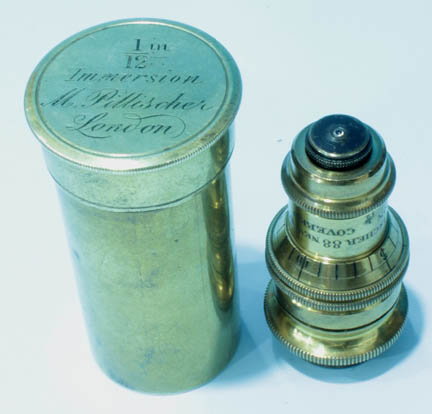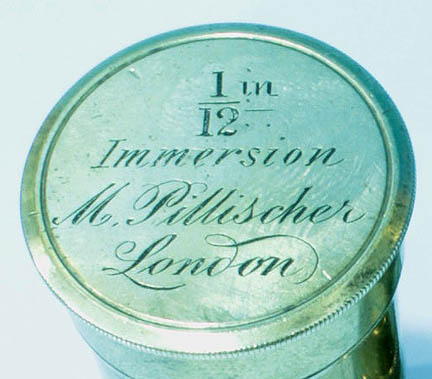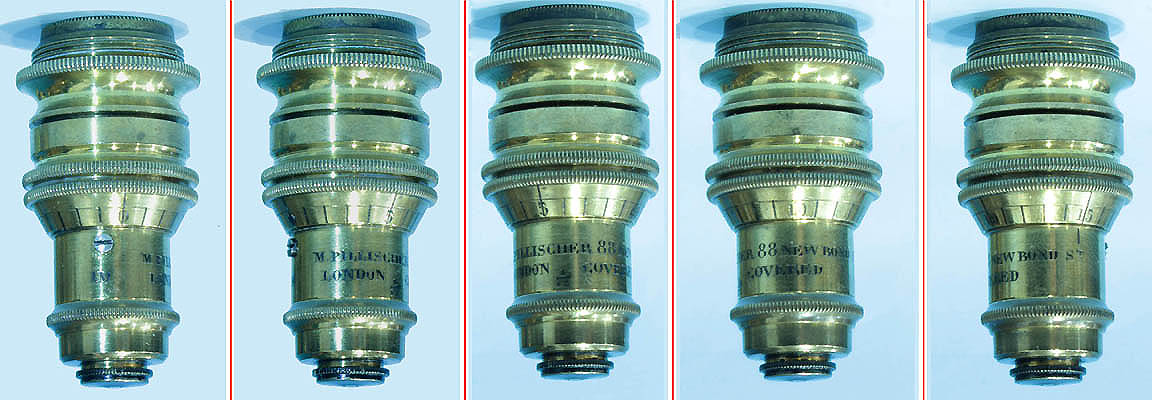1/12 INCH WATER IMMERSION OBJECTIVE BY PILLISCHER
MAKER: PILLISCHER
c. 1873

DESCRIPTION:
 This is a fine water immersion objective sold by Pillischer from c. 1873. It features a RMS thread and correction collar. The correction collar registers against a vertical line inscribed above the
This is a fine water immersion objective sold by Pillischer from c. 1873. It features a RMS thread and correction collar. The correction collar registers against a vertical line inscribed above the T
in the address abbreviation for street.
The can is signed:
1 in, Immersion, M. Pillischer, London
12
The objective itself is signed:
M. Pilliischer 88 New Bond ST
London 1 covered IM,
12
The objective is in excellent condition and the correction collar works smoothly. The can is in very good condition, though the lacquer is worn on the main (lower) part of the can.

HISTORY OF WATER IMMERSION OBJECTIVES:
Water immersion objectives are designed to be used with water as a medium between the coverslip and the objective. Water, with a refractive index(RI) of 1.33 is much closer than air (RI 1.0) to the refractive index of glass (about 1.5-1.55 for crown glass and about 1.57-1.62 for flint glass). This leads to much better resolution* at a given power, and this is especially important at high powers. Pillischer advertised in his 1873 catalog:
I would call particular attention to my new series of high power correction and immersion Object Glasses, which I have only recently improved and perfected...
The idea of using a fluid between the objective and the slide (or coverslip)was first conceived by Amici in the early 1850s, and this fluid was initially water. Apparently he also experimented with oil, but soon abandoned its use. Amici used immersion to reduce aberration, but did not use this method to improve resolution. Water immersion objectives were then introduced widely in France & Germany, notably by Hartnack who added the correction collar to them in 1859. In 1858 Tolles in the USA constructed water immersion objectives, and Wales followed shortly thereafter.
The first water immersion objectives made in England were made by Powell & Lealand about 1869. Ross was making water immersion objectives by 1870, and as noted, they were made by Pillischer no later than 1873. Other makers including John Browning also made water immersion objectives. An example of a Browning Water Immersion Objective is in the Author's collection.
As time went on, workers looked to immersion media with refractive indices closer to glass. This started with glycerin (RI 1.4), first made by Gundlach in 1867, and by Tolles that same year. In 1871 Tolles first introduced soft Canada Balsam which, with a RI close to class, became a standard until easier-to-use* media became available.
The ability of an objective to resolve fine details was in those days related to the angle of aperture (A
in air) and with the advent of Balsam immersion, the Balsam angle (BA
) became used for Balsam immersion. As time went on, and after extensive experimentation, Abbe, in 1877, concluded that Cedar Wood oil, much easier to use than softened Balsam, had a RI closer to glass and for many years it was the standard immersion medium until synthetic oils replaced it. The angle of aperture using different mediums however was not directly comparable.
In 1873 Abbe first described the equation that relates to total aperture, taking into account the medium between the lens and the coverslip. This formula, deriving a number now known as the numerical aperture is:
n.a.=n(sin m)
where n=the refractive index of the medium between the lens and the coverslip, and m=1/2 the angular aperture of the objective in air. This term, n.a. is still used today to compare the resolution of different microscope objectives and the n.a. of any particular objective is usually inscribed on it.
There is sometimes confusion by antique microscope collectors over what kind of objective they are dealing with.
Correction collars are often present on higher power objectives for use in air, but they are also found on water immersion objectives because the RI of water, although much closer to the RI of glass than air, is not the same as the coverglass RI. Generally they are not needed for oil immersion objectives, when the oil has the same RI as the glass of the coverslip. Oil immersion objectives therefore usually have no correction collar, but some, particularly by Powell & Lealand still had correction collars when the oils available were not exactly the same refractive index as the glass used for coverslips. Water Immersion objectives were often labeled with IMM
or as in the case of the objective on this page, IM
. Oil immersion objectives were referred to as homogenous immersion
because the refractive index from the glass of the objective through the coverslip. Oil immersion objectives often have the label of Homog immers
, HI
oil imm
or simply oil
or in German "oel". Finally, one should not confuse a water immersion objective with an immersible objective used directly in liquids without a coverglass, a very specialized and uncommon form. In the modern era, some (uncommon) objectives had adjustments and indicator labels for adjustments for use with air, glycerin, or oil in the same objective, but assuming a standard coverslip thickness, so a correction collar was not needed.
*Soft Canada Balsam tends to harden quickly, and is difficult to remove.
**For a more complete discussion about resolution please see the discussion on the Leica Microscope Site.

 This is a fine water immersion objective sold by Pillischer from c. 1873. It features a RMS thread and correction collar. The correction collar registers against a vertical line inscribed above the
This is a fine water immersion objective sold by Pillischer from c. 1873. It features a RMS thread and correction collar. The correction collar registers against a vertical line inscribed above the 